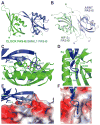Crystal structure of the heterodimeric CLOCK:BMAL1 transcriptional activator complex
- PMID: 22653727
- PMCID: PMC3694778
- DOI: 10.1126/science.1222804
Crystal structure of the heterodimeric CLOCK:BMAL1 transcriptional activator complex
Abstract
The circadian clock in mammals is driven by an autoregulatory transcriptional feedback mechanism that takes approximately 24 hours to complete. A key component of this mechanism is a heterodimeric transcriptional activator consisting of two basic helix-loop-helix PER-ARNT-SIM (bHLH-PAS) domain protein subunits, CLOCK and BMAL1. Here, we report the crystal structure of a complex containing the mouse CLOCK:BMAL1 bHLH-PAS domains at 2.3 Å resolution. The structure reveals an unusual asymmetric heterodimer with the three domains in each of the two subunits--bHLH, PAS-A, and PAS-B--tightly intertwined and involved in dimerization interactions, resulting in three distinct protein interfaces. Mutations that perturb the observed heterodimer interfaces affect the stability and activity of the CLOCK:BMAL1 complex as well as the periodicity of the circadian oscillator. The structure of the CLOCK:BMAL1 complex is a starting point for understanding at an atomic level the mechanism driving the mammalian circadian clock.
Figures





Comment in
-
Biochemistry. Nature's intricate clockwork.Science. 2012 Jul 13;337(6091):165-6. doi: 10.1126/science.1224611. Science. 2012. PMID: 22798591 No abstract available.
References
Publication types
MeSH terms
Substances
Associated data
- Actions
Grants and funding
LinkOut - more resources
Full Text Sources
Other Literature Sources
Molecular Biology Databases
Research Materials

